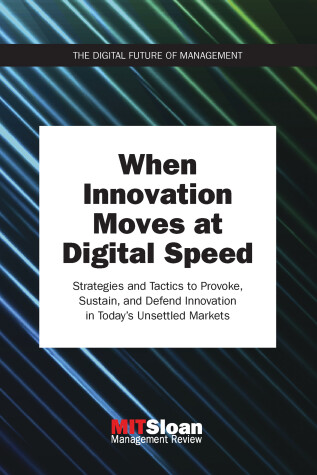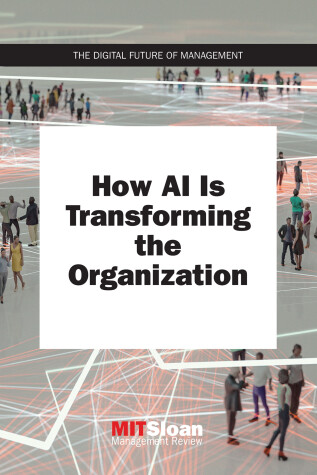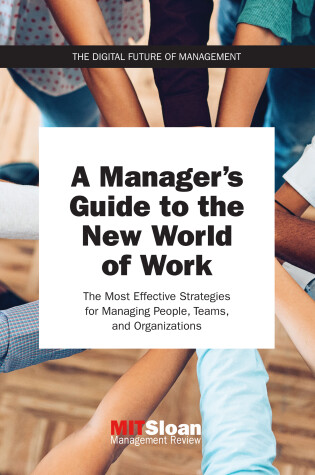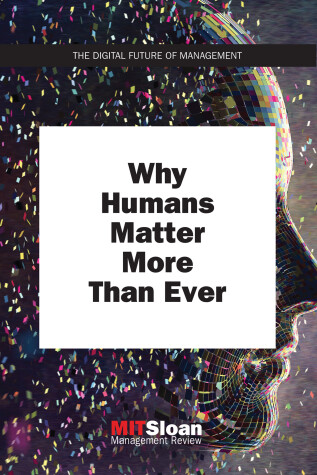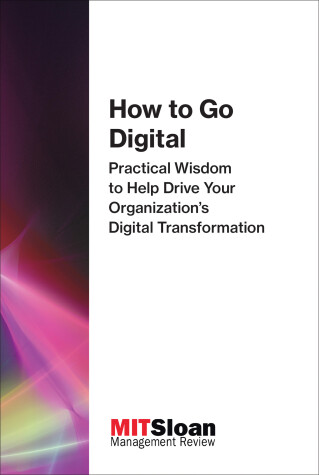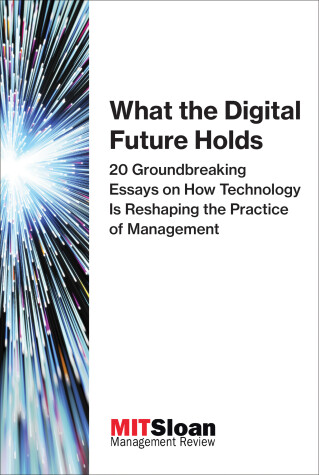Digital Future of Management
7 total works
In the new digital world, the unknowns are never-ending. Our ability to embrace the demands of change has become a prerequisite for success. It's not easy. We don't work the way we did last year. Next year, it will all change again. If an organization doesn't embrace the realities of change, it will be under siege from those that do. Who Wins in a Digital World explains how organizations can adapt to a constantly changing business environment by being flexible but focused, embracing change in all its messiness, and moving fast.
In articles that originally appeared in MIT Sloan Management Review, experts from business and academia discuss digital adaptability, explaining how both organizations and individuals need the ability to excel in what their roles will become as technology and their competitive ecosystem evolve. They highlight strategies and mindsets that can foster change, including boldness in the face of digitization, a focus on collaboration, and an artificial intelligence game plan. And they explore the need for speed, with one contributor declaring: “Implement first, ask questions later (or not at all).”
Once an organization accepts the fact that technological change is ongoing and inevitable, it becomes more about opportunity and less about challenge. This book shows that change can be stimulating, exhilarating, and something to be welcomed.
Contributors
Stephen J. Andriole, Jacques Bughin, Thomas H. Davenport, Nathan Furr, Lynn J. Good, David Kiron, Edward E. Lawler III, Vikram Mahidhar, Paul Michelman, Jeanne Ross, Paul J. H. Schoemaker, Andrew Shipilov, Charles Sull, Donald Sull, Philip E. Tetlock, Stefano Turconi, Nicolas van Zeebroeck, Peter Weill, Thomas Williams, Stephanie L. Woerner, Christopher G. Worley, James Yoder
All organizations grapple with what digitalization means for their business and, in particular, how digital forces will drive their approaches to innovation. But very few organizations have clearly defined the scale, speed, and scope of their engagement with the digital world. These essays, from the pages of the preeminent journal MIT Sloan Management Review, offer practical advice from experts on how to create, facilitate, and manage innovation in and for today's digital markets.
The essays emphasize the power of intersections, where different mindsets and skills collide. These connections can be external—LEGO, for example, has engaged more than 100,000 adult fans in user communities—or internal, as when “brokers,” “connectors,” and “energizers” act within organizations. Contributors stress the value of action over analysis, citing examples that affirm the power of trial-and-error experimentation. They demonstrate that innovation success requires thinking beyond technology. Innovation is not created by white-coated scientists in a lab; it is not the job of the few but of the many. And finally, the contributors warn that the greatest enemy lies within; innovators often encounter fierce internal resistance. They consider innovations in the innovation process itself, describing the promise and pitfalls of “design thinking” and offering advice on how to manage the tension between new and existing business models.
Innovation is not a magical act practiced by a select few with rare gifts. Innovation is a discipline that can be measured, managed, and improved. When Innovation Moves at Digital Speed provides practical guidance for innovation success.
Contributors
Daniel Amaral, Jamie Anderson, Scott D. Anthony, Yun Mi Antorini, Michael Arena, Tormod Askildsen, Michael Ballé, Thomas Bartman, Jennie Björk, Marcel Bogers, Anna Brattström, Clayton M. Christensen, Edivandro Carlos Conforto, Rob Cross, Charles Dhanaraj, Thomas Fink, Nicolai J. Foss, Johan Frishammar, Johann Harnoss, Srivardhini K. Jha, Lâle Kesebi, Rishikesha T. Krishnan, Martin Kupp, Sean Looram, Mats Magnusson, Ann Majchrzak, Arvind Malhotra, James Morgan, Albert M. Muñiz, Jr., Ramiro Palma, Ishwardutt Parulkar, Eric Rebentisch, Jörg Reckhenrich, Martin Reeves, Anders Richtnér, Dave Rochlin, Duncan Simester, Jonathan Sims, Joseph V. Sinfield, Durward K. Sobek II, Freddy Solis, Kristian J. Sund, Mary Uhl-Bien, Derek van Bever, J. Andrei Villarroel, Amy Webb
A clear-eyed look at how AI can complement (rather than eliminate) human jobs, with real-world examples from companies that range from Netflix to Walmart.
Descriptions of AI's possible effects on businesses and their employees cycle between utopian hype and alarmist doomsaying. This book from MIT Sloan Management Review avoids both these extremes, providing instead a clear-eyed look at how AI can complement (rather than eliminate) human jobs, with real-world examples from companies that range from Netflix to Walmart. The contributors show that organizations can create business value with AI by cooperating with it rather than relinquishing control to it. The smartest companies know that they don't need AI that mimics humans because they already have access to resources with human capability-actual humans.
The book acknowledges the prominent role of such leading technology companies as Facebook, Apple, Amazon, Netflix, and Google in applying AI to their businesses, but it goes beyond the FAANG cohort to look at AI applications in many nontechnology companies, including DHL and Fidelity. The chapters address such topics as retraining workers (who may be more ready for change than their companies are); the importance of motivated and knowledgeable leaders; the danger that AI will entrench less-than-ideal legacy processes; ways that AI could promote gender equality and diversity; AI and the global loneliness epidemic; and the benefits of robot-human collaboration.
Contributors
Cynthia M. Beath, Megan Beck, Joe Biron, Erik Brynjolfsson, Jacques Bughin, Rumman Chowdhury, Paul R. Daugherty, Thomas H. Davenport, Chris DeBrusk, Berkeley J. Dietvorst, Janet Foutty, James R. Freeland, R. Edward Freeman, Julian Friedland, Lynda Gratton, Francis Hintermann, Vivek Katyal, David Kiron, Frieda Klotz, Jonathan Lang, Barry Libert, Paul Michelman, Daniel Rock, Sam Ransbotham, Jeanne W. Ross, Eva Sage-Gavin, Chad Syverson, Monideepa Tarafdar, Gregory Unruh, Madhu Vazirani, H. James Wilson
How can technology and analytics help companies manage people? Why do teams working remotely still need leaders? When should organizations use digital assessment tools for gauging talent and potential? This book from MIT Sloan Management Review answers questions managers are only beginning to ask, presenting insights and stories from organizations navigating the novel challenges of the digital workplace.
Experts from business and academia describe what's worked, what's failed, and what they've learned in the new world of work. They look at strategies that organizations use to help managers and employees adapt to the fast-changing digital environment, from the benefits of wool-gathering to the use of anonymous chats; examine digital tools for collaboration, including interactive spreadsheets and analytics that increase transparency; and discuss such “big-picture” trends as expanded notions of value and new frontiers in upskilling. A detailed case study, produced by MIT Sloan Management Review in collaboration with McKinsey & Company, explores how IBM reimagined talent and performance management with the goal of increasing employee engagement.
Contributors
Steve Berez, Ethan Bernstein, Josh Bersin, Matthew Bidwell, Ryan Bonnici, Tomas Chamorro-Premuzic, Rob Cross, Chris DeBrusk, Federica De Stefano, Thomas H. Davenport, Angela Duckworth, Ken Favaro, Lynda Gratton, Peter Gray, Lindred Greer, John Hagel III, Manish Jhunjhunwala, David Kiron, Frieda Klotz,, David Lazer, Massimo Magni, Likoebe Maruping, Kelly Monahan, Will Poindexter, Reb Rebele, Adam Roseman, Michael Schrage, Jeff Schwartz, Jesse Shore, Brian SolisBarbara Spindel, Anna A. Tavis, Adam Waytz,, David Waller, Maggie Wooll
Experts offer strategies for managing people in technocentric times.
In these technocentric times, it is more important than ever to manage people well. Companies-employees and managers-may feel overwhelmed by the never-ending disruptions caused by new technologies. This volume in the Digital Future of Management series shows why we should step back, take stock, and seize just a bit more control over how our world is evolving. In Why Humans Matter More Than Ever, management experts from both industry and academia offer strategies for managing people in our brave new digital world.
The contributors explain how new technologies, even the most sophisticated artificial intelligence agents, depend on human collaboration. Companies need to develop rules, principles, and clear ethical guidelines that structure smart object-human interactions. Moreover, in a world filled with technology distractions, we must learn to how to manage our most valuable personal resource: our attention. Leaders need to step up to prepare their organizations for the evolution of work, showing them how to adapt, be more collaborative, and learn new skills. As virtual collaborations take place across professions, locations, and industries, we must adopt the best practices in virtual communication. Finally, going beyond empathy and curiosity, leaders should be self-aware enough to remind themselves of what they may be missing-even the best managers don't know everything.
Contributors
Lynne Andersson, Robert D. Austin, Catherine Bailey, Kathryn M. Bartol, Daniel Han Ming Chng, Chris DeBrusk, Arati Deo, Kishore Durg, Lauren Eskreis-Winkler, Mallika Fernandes, Ayelet Fishbach, Fritz Fleischmann, Kristen Getchell, Bhaskar Ghosh, Brad Gilbreath, Rob Gleasure, Sergey Gorbatov, Lynda Gratton, N. Sharon Hill, Beth Humberd, Bala Iyer, Tae-Yeol Kim, Frieda Klotz, Angela Lane, Scott Latham, Thomas W. Malone, Daniel McDuff, Alain Pinsonneault, Yasser Rahrovani, Fabrizio Salvador, Amanda Shantz, Antti Tenhiala, Jan vom Brocke, Eoin Whelan
Advice on how companies can succeed in the new digital business environment.
The most important skills a leader needs to succeed in a digital environment are not technical in nature but managerial-strategic vision, forward-looking perspective, change-oriented mindset. A company's digital transformation does not involve abandoning widget-making for app developing or pursuing "disruption" at the cost of stability. Rather, it is about adopting business processes and practices that position organizations to compete effectively in the digital environment. More important than technology implementation are strategy, talent management, organizational structure, and leadership aligned for the digital world. How to Go Digital offers advice from management experts on how to steer your company into the digital future.
The book will put you on the right strategic path, with articles from MIT Sloan Management Review on developing a digital strategy, reframing growth for a digital world, monetizing data, and generating sustainable value from social media. Talent acquisition and retention are addressed, with articles on HR analytics, data translators, and enabling employees to become brand ambassadors outside of the office. Operational makeovers are discussed in terms of sales, services, new technologies, and innovation.
Contributors
Allan Alter, Stephen J. Andriole, Bart Baesens, Gloria Barczak, Cynthia M. Beath, Alpheus Bingham, Didier Bonnet, Chris Brady, Joseph Byrum, Marina Candi, Manuel Cebrian, Marie-Cecile Cervellon, Simon Chadwick, Sophie De Winne, Mike Forde, Gerald C. Kane, Rahul Kapoor, David Kiron, Thomas Klueter, Mary C. Lacity, Rikard Lindgren, Pamela Lirio, Tucker J. Marion, Lars Mathiassen, Pete Maulik, Paul Michelman, Narendra Mulani, Pierre Nanterme, Doug Palmer, Alex "Sandy" Pentland, Anh Nguyen Phillips, Frank T. Piller, Iyad Rahwan, Deborah L. Roberts, Jeanne W. Ross, Ina M. Sebastian, Luc Sels, James E. Short, Fredrik Svahn, Steve Todd, Leslie P. Willcocks, H. James Wilson, Barbara H. Wixom
The relationship between management and digital technology: experts present a new agenda for the practice of management.
Digital technology has profoundly affected the ways that businesses design and produce goods, manage internal communication, and connect with customers. But the next phase of the digital revolution raises a new set of questions about the relationship between technology and the practice of management. Managers in the digital era must consider how big data can inform hiring decisions, whether new communication technologies are empowering workers or unleashing organizational chaos, what role algorithms will play in corporate strategy, and even how to give performance feedback to a robot. This collection of short, pithy essays from MIT Sloan Management Review, written by both practitioners and academic experts, explores technology's foundational impact on management.
Much of the conversation around these topics centers on the evolving relationship between humans and cognitive technologies, and the essays reflect this-considering, for example, not only how to manage a bot but how cognitive systems will enhance business decision making, how AI delivers value, and the ethics of algorithms.
Contributors
Ajay Agrawal, Robert D. Austin, David H. Autor, Andrew Burgert, Paul R. Daugherty, Thomas H. Davenport, R. Edward Freeman, Joshua S. Gans, Avi Goldfarb, Lynda Gratton, Reid Hoffman, Bala Iyer, Gerald C. Kane, Frieda Klotz, Rita Gunther McGrath, Paul Michelman, Andrew W. Moore, Nicola Morini-Bianzino, Tim O'Reilly, Bidhan L. Parmar, Ginni Rometty, Bernd Schmitt, Alex Tapscott, Don Tapscott, Monideepa Tarafdar, Catherine J. Turco, George Westerman, H. James Wilson, Andrew S. Winston

